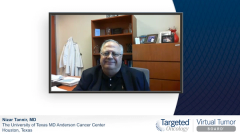
Adjuvant Therapy in Clear Cell RCC
Experts discuss the use of pembrolizumab as an adjuvant therapy in advanced clear cell RCC.
Episodes in this series

Nizar Tannir, MD: In the interest of time and the topic of adjuvant therapy based on the recently approved pembrolizumab from KEYNOTE-564, I’d like to go to the next segment and talk a little about adjuvant therapy and get your thoughts about that. Let’s talk about this case quickly and then review some of the data for adjuvant therapy for clear cell RCC [renal cell carcinoma].
This is a 65-year-old man who developed abdominal pain and was found to have a right renal mass that measured 4.6 cm in the right kidney. He didn’t have metastatic disease, weight loss, hematuria, fever, or pain. He had a CT scan of the chest, which was normal. Laboratory results were normal. He underwent a right radical nephrectomy, and the pathology was consistent with clear cell RCC. It was grade 3, measuring 5.2 cm in size. There were no sarcomatoid or rhabdoid features. The tumor invaded branches of the renal vein. He was staged as stage III (pT3a) because of the renal vein involvement. There were no lymph nodes sampled, and he didn’t have metastatic disease. He clearly had stage III disease.
What do we have now in terms of data that can guide us in recommending adjuvant therapy? Here’s a question to both of you, starting with Scott. Since the approval of pembrolizumab in the adjuvant setting based on KEYNOTE-564, which I will review in the next few slides, have you used pembrolizumab as adjuvant therapy in a patient like this?
Scott Tykodi, MD, PhD: Yes. We were a participating site in KEYNOTE-564 and had a couple of patients in the study. Since the FDA approval, I’ve used it for a handful of other patients. The complete menu of options is sunitinib, which was approved in 2017, and pembrolizumab. I don’t think I’ve ever had a patient who came to me from the community and got adjuvant sunitinib. I’ve done it myself in a handful of patients. But as we teach our fellows, show them the breadth of negative studies of targeted monotherapy of the adjuvant studies that have been done. It’s quite disappointing. You wonder whether the S-TRAC trial is just a funny outlier and there isn’t true efficacy there.
I’m not gung ho on the TKI [tyrosine kinase inhibitor], and I’ve embraced pembrolizumab as having a more convincing data set and hopefully less overall toxicity. You obviously can create some problems in a subset of patients. But I’d be surprised to see patients offered sunitinib unless they have some strong contraindications to IO [immunotherapy]. Pembrolizumab is clearly the drug of choice in the adjuvant space.
Nizar Tannir, MD: Have you seen more referrals to your practice from urologists, the community, or other medical oncologists who wanted to refer to your center for your recommendation regarding giving them adjuvant pembrolizumab? At our center, we have seen huge numbers of patients being referred, both internally from our urology colleagues as well as from outside. I’d like to know if you’re seeing the same thing in Seattle and Cleveland.
Scott Tykodi, MD, PhD: Most of our referrals have come from our own surgical team. Not that many have come from the community. One interesting feature of KEYNOTE-564 is the breadth of risk enrolled in that study, all the way down to T2 high-grade tumors. I have never had a patient referred to me with a T2 for adjuvant therapy. Urologists [don’t know] that’s even a connection there. It’s got to be an ugly stage III before they start thinking about systemic therapy being appropriate. Does your surgical team hand off their T2 tumors to you, or is that something you don’t get very often?
Nizar Tannir, MD: Our urologists have been sending us stage III, T4s, and T3 if they are node positive. You’re right. We’ll show these data. KEYNOTE-564 included patients with T2 disease if they had sarcomatoid or grade 4. As we’ll show in the slides, that was the bulk of the patients. The bulk of the patients—86%—enrolled on the drug were T2 high grade. Moshe, what’s your view at the Cleveland Clinic?
Moshe Ornstein, MD, MA: It’s interesting. After sunitinib was approved 4 or 5 years ago for adjuvant therapy, there was initially a wave of patients being referred. But as the data—in terms of DFS [disease-free survival] and the absence of OS [overall survival] advantage—became more apparent to the urologists, those referrals slowed. Now it’s a rush. We’re seeing a lot of patients. Ours come primarily internally, but we have extremely high surgical volumes, so we’re seeing a lot of patients and many referrals.
We also aren’t seeing the T2 patients. But even this patient presented here is a T3a and falls into a risk that was included in the trial, albeit on the lower end of the risk. This patient didn’t have sarcomatoid features. Although this patient isn’t a T2—they were T3a—it isn’t necessarily the highest of risks. But this patient certainly would have been approved. Now it’s almost automatic when there’s a T3, stage III or above. We’ve even started getting more referrals for metastasectomies based on the data that I’m sure you’ll show.
Transcript edited for clarity.










































